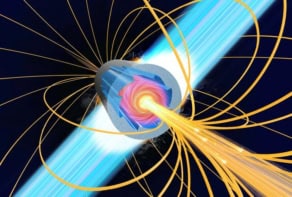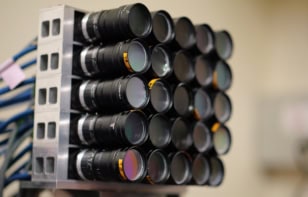Terahertz beams could be employed in many scientific and technological applications, such as biological imaging, security screening and materials science. Now these applications are a step closer, as researchers in the US and Switzerland have made the first room-temperature coherent terahertz source based on commercially available semiconductor nanotechnology.
Terahertz radiation lies between the microwave and far-infrared regions of the electromagnetic spectrum, at wavelengths from about 1 to 0.03 mm. Until now, the only compact semiconductor lasers to emit light at terahertz wavelengths were “quantum cascade” lasers (QCLs). These devices comprise many identical stages made of nanometre-thick quantum wells.
When a voltage is applied, electrons briefly hop into a quantum-well energy-level before dropping down into a lower one, emitting a photon in the process. The same electrons are then injected into a new stage where they emit another photon. In this way, as many photons as there are stages are emitted by a single electron “cascading” through the structure.
Until now, however, QCLs have only been able to emit terahertz radiation at cryogenic temperatures of less than 200 K. The new QCL device — made by Federico Capasso of the Harvard School of Engineering and Applied Sciences and colleagues from Texas A&M University and ETH Zurich — emits terahertz radiation with several-hundred nanowatts of power at room temperature (Appl. Phys. Lett. 92 201101). At commercially available thermoelectric cooler temperatures around 259 K this power is increased to microwatts. Moreover, the power can be further increased up to a few milliwatts by optimizing the semiconductor nanostructure layers of the laser’s active region and by improving the extraction efficiency of the terahertz radiation.
The team made their QCL from a material that exhibits “difference-frequency generation” (DFG). This means that when it is illuminated by two frequencies of light, the electrons re-emit photons at both of the individual frequencies as well as the frequency difference. When the two frequencies are in the mid-infrared, the QCL can produce a difference frequency of 5 THz.
Terahertz radiation sources based on DFG have been around for years, but they have required powerful pump lasers and large non-linear crystals to generate the required frequency difference. In contrast, the new device is electrically pumped. “Our device does everything in one small semiconductor crystal a few millimetres in size with no need for bulky external lasers,” explains Capasso. “This means the device is compact, portable and consumes little power.”
Since terahertz radiation can pass through most materials except metals, it could be used to detect concealed weapons or explosive chemicals, or to image biological samples. “Detecting material defects, such as cracks in foam, is also an important application,” adds Capasso.
The researchers will now work on increasing the output power of their coherent terahertz source at room temperature, as well as at thermoelectric cooler temperatures. They will do this by increasing the surface area used for light emission and by optimizing the design of the quantum wells.
“This is a very exciting and important result as it circumvents problems associated with normal terahertz semiconductor lasers, which only work at low temperatures,” says Christian Pflügl of Harvard University, who was not involved in the research. “This novel approach could lead to the realization of compact semiconductor light sources with output powers sufficient for many spectroscopic applications, such as studies of pharmaceutical products, drug detection and determination of disease in skin tissue.”


